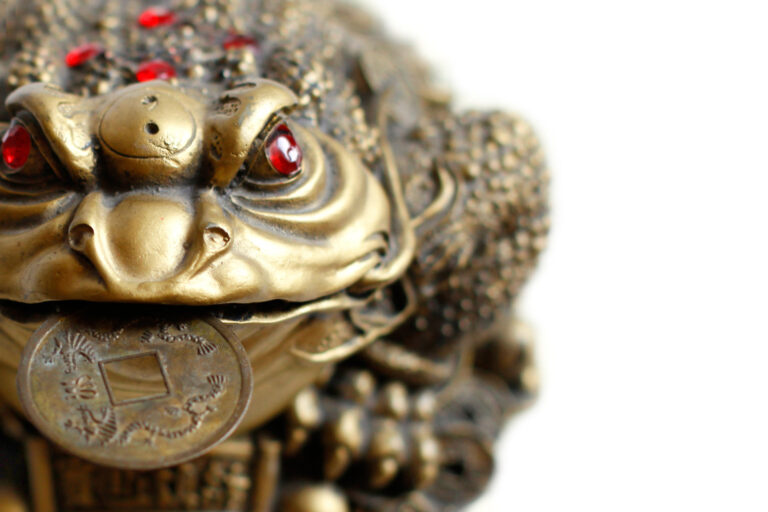The Feng Shui Money Frog, also known as Jin Chan (Golden Toad) in Chinese culture, is an auspicious mascot renowned for enhancing wealth luck.
This charismatic figure can be seen in homes, offices, shopping malls, stores, and various other places, serving as a magnet for prosperity and abundance.
The typical depiction of the Money Frog is a three-legged toad with its back towards the Big Dipper, a Tai Chi symbol on its head, and a mouth biting onto a copper coin, symbolizing a ceaseless inflow of wealth.
However, achieving the Money Frog’s full potential requires a thorough understanding of its placement methods and taboos.
Did You Know?
The Feng Shui Money Frog, despite its frog-like appearance, is actually based on a mythical toad? This toad is said to have the power to summon the clouds and bring rain, which is often associated with wealth in Chinese culture.
Table of Contents
1. How to Place the Feng Shui Money Frog
The Money Frog carries two significant functions: warding off evil spirits and attracting wealth. Nevertheless, the effectiveness of these functions highly depends on its placement.
Placing your Money Frog in an inauspicious location in an office or home may serve the purpose of warding off evil spirits, but it would fail to attract wealth.
On the contrary, placing the Money Frog in the wealth sector can maximize its effectiveness in drawing wealth and improving overall Feng Shui energy.
The Money Frog does not reside in non-wealth areas – the essence of Feng Shui tells us that its true power lies in attracting and accumulating wealth.
2. Proper Money Frog Placement Position
When deciding on the placement position, consider the homeowner’s Five Elements and Eight Characters. If these factors make it challenging to determine the precise location of the unlucky or wealth sector, it’s recommended to consult a Feng Shui master.
A common practice is to place the Money Frog at the entrance of a home, or on the cash register in a store. You can also place it on a desk in a study, office, living room, or bedroom.
Placement Taboos: The Feng Shui Money Frog should never be placed directly under a crossbeam, as it can create oppressive energy and prevent the mascot from effectively attracting wealth.
3. The Significance of the Coin that the Money Frog Bites Onto
An interesting feature of the Feng Shui Money Frog is the copper coin it holds in its mouth. The coin often features a square hole in the center, which carries a profound meaning.
The square represents the Earth, and the hole allows the free flow of Chi energy. The coin in the Money Frog’s mouth represents the flow of wealth energy into your space.
Did You Know?
The Feng Shui Money Frog’s red eyes aren’t merely for aesthetic appeal; they’re symbolic of vigilance and the continual search for new opportunities.
4. Choosing the Correct Orientation for Your Feng Shui Money Frog
Depending on whether your Money Frog is depicted with a coin in its mouth, the placement orientation varies. A Money Frog with a coin should be facing inward, representing existing wealth and symbolizing the attraction of wealth.
An empty-mouthed Money Frog should face outward, signifying the absorption of wealth and serving the purpose of guarding your treasury.
5. Feng Shui Frog Placement Time
The best time to place your Feng Shui Frog is during the Chen hour (7 a.m. to 9 a.m.), corresponding to when the dragon raises its head, an auspicious time. It’s crucial to maintain cleanliness when placing your Money Frog and during subsequent uses.
Harnessing the power of the Feng Shui Money Frog for wealth attraction can be a rewarding endeavor. However, achieving desired results requires an understanding of the correct practices and taboos. By following these guidelines, you can invite greater wealth and prosperity into your life.
Unleashing the Potential of the Feng Shui Money Frog
The Feng Shui Money Frog is a symbol imbued with the rich lore of Chinese culture. Its promise of attracting wealth and prosperity has charmed countless individuals and businesses worldwide.
Yet, its effectiveness goes beyond mere placement—it calls for a deeper understanding of Feng Shui principles, respect for cultural taboos, and a profound connection with the Money Frog itself.
With this, we leave you with an intriguing question: If the Feng Shui Money Frog could speak, what wealth secrets do you think it would whisper to you? How would you harness its advice to usher in prosperity and abundance into your life?
Remember, the path to wealth often starts with acknowledging the symbols that resonate with us. And who knows? Your Money Frog might just be waiting to leap you into a prosperous future. Let us know your thoughts below!
Why does the Feng Shui Money Frog have three legs?
The three-legged Money Frog is a symbolic representation of prosperity and wealth in Chinese culture, with each leg representing the holy trinity of heaven, earth, and humanity.
Where should I not place my Feng Shui Money Frog?
Avoid placing your Money Frog under beams, higher than deity statues, or facing washrooms, fish tanks, or Buddha statues to prevent unfavorable energy clashes.
What does the coin in the Feng Shui Money Frog’s mouth signify?
The coin represents wealth. The square hole in the coin signifies the Earth, and the opening allows for the free flow of Chi energy, symbolizing the continuous flow of wealth into your home or business.
What does it mean if my Feng Shui Money Frog doesn’t have a coin?
A Feng Shui Money Frog without a coin, often known as an empty-mouthed Money Frog, symbolizes the protection of wealth. Its orientation should face outward, signifying the absorption of wealth from outside.
Does the Feng Shui Money Frog really work?
Feng Shui is a practice that aligns your environment with desired outcomes, such as wealth attraction. The Feng Shui Money Frog is a powerful symbol of wealth, and when placed correctly, it can attract wealth energy into your life.
What is the significance of the number of crystals on the back of a Feng Shui Money Frog?
The Feng Shui Money Frog, also known as the Three-legged Toad or Chan Chu, is traditionally depicted with seven diamonds or crystals on its back. These seven jewels represent the Ursa Major or the Big Dipper constellation, symbolizing celestial blessings and protection.



